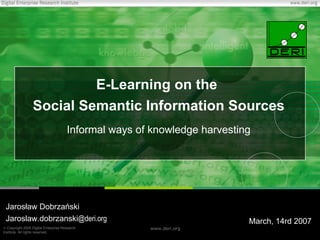E-Learning on the Social Semantic Information Sources
•
4 likes•1,130 views
I present the idea of Social Semantic Information Sources (SSIS) and make a review of SSIS. I point out how important role SSIS play in e-Learning (informal sources of knowledge). I present a new idea of Learning Management System that derives from formal and informal sources of information.
Report
Share
Report
Share

Recommended
Recommended
More Related Content
What's hot
What's hot (20)
Effectiveness of blogging to practice reading at a freshman efl program

Effectiveness of blogging to practice reading at a freshman efl program
FACC teaching the millennial generation - techno savvy

FACC teaching the millennial generation - techno savvy
Developing an Online Course Based on E-Learning 2.0 Concepts

Developing an Online Course Based on E-Learning 2.0 Concepts
Feb 11 2014 MultiMOOC and ICT4ELT EVO sessions joint event - Once a Webhead a...

Feb 11 2014 MultiMOOC and ICT4ELT EVO sessions joint event - Once a Webhead a...
Using Social Networking to Enhance Students’ Learning Experiences

Using Social Networking to Enhance Students’ Learning Experiences
Similar to E-Learning on the Social Semantic Information Sources
Similar to E-Learning on the Social Semantic Information Sources (20)
Libraries and Social Software: City University 2009

Libraries and Social Software: City University 2009
Multichannel Self-Organized Learning and Research in Web 2.0 Environment

Multichannel Self-Organized Learning and Research in Web 2.0 Environment
Libraries And Social Software: Aliss conference 2008

Libraries And Social Software: Aliss conference 2008
Recently uploaded
https://app.box.com/s/x7vf0j7xaxl2hlczxm3ny497y4yto33i80 ĐỀ THI THỬ TUYỂN SINH TIẾNG ANH VÀO 10 SỞ GD – ĐT THÀNH PHỐ HỒ CHÍ MINH NĂ...

80 ĐỀ THI THỬ TUYỂN SINH TIẾNG ANH VÀO 10 SỞ GD – ĐT THÀNH PHỐ HỒ CHÍ MINH NĂ...Nguyen Thanh Tu Collection
https://app.box.com/s/7hlvjxjalkrik7fb082xx3jk7xd7liz3TỔNG ÔN TẬP THI VÀO LỚP 10 MÔN TIẾNG ANH NĂM HỌC 2023 - 2024 CÓ ĐÁP ÁN (NGỮ Â...

TỔNG ÔN TẬP THI VÀO LỚP 10 MÔN TIẾNG ANH NĂM HỌC 2023 - 2024 CÓ ĐÁP ÁN (NGỮ Â...Nguyen Thanh Tu Collection
Recently uploaded (20)
ICT Role in 21st Century Education & its Challenges.pptx

ICT Role in 21st Century Education & its Challenges.pptx
Python Notes for mca i year students osmania university.docx

Python Notes for mca i year students osmania university.docx
Unit 3 Emotional Intelligence and Spiritual Intelligence.pdf

Unit 3 Emotional Intelligence and Spiritual Intelligence.pdf
HMCS Vancouver Pre-Deployment Brief - May 2024 (Web Version).pptx

HMCS Vancouver Pre-Deployment Brief - May 2024 (Web Version).pptx
80 ĐỀ THI THỬ TUYỂN SINH TIẾNG ANH VÀO 10 SỞ GD – ĐT THÀNH PHỐ HỒ CHÍ MINH NĂ...

80 ĐỀ THI THỬ TUYỂN SINH TIẾNG ANH VÀO 10 SỞ GD – ĐT THÀNH PHỐ HỒ CHÍ MINH NĂ...
Beyond_Borders_Understanding_Anime_and_Manga_Fandom_A_Comprehensive_Audience_...

Beyond_Borders_Understanding_Anime_and_Manga_Fandom_A_Comprehensive_Audience_...
Food safety_Challenges food safety laboratories_.pdf

Food safety_Challenges food safety laboratories_.pdf
HMCS Max Bernays Pre-Deployment Brief (May 2024).pptx

HMCS Max Bernays Pre-Deployment Brief (May 2024).pptx
On National Teacher Day, meet the 2024-25 Kenan Fellows

On National Teacher Day, meet the 2024-25 Kenan Fellows
Salient Features of India constitution especially power and functions

Salient Features of India constitution especially power and functions
TỔNG ÔN TẬP THI VÀO LỚP 10 MÔN TIẾNG ANH NĂM HỌC 2023 - 2024 CÓ ĐÁP ÁN (NGỮ Â...

TỔNG ÔN TẬP THI VÀO LỚP 10 MÔN TIẾNG ANH NĂM HỌC 2023 - 2024 CÓ ĐÁP ÁN (NGỮ Â...
UGC NET Paper 1 Mathematical Reasoning & Aptitude.pdf

UGC NET Paper 1 Mathematical Reasoning & Aptitude.pdf
E-Learning on the Social Semantic Information Sources
- 1. E -Learning on the Social Semantic Information Sources Informal ways of knowledge harvesting Jarosław Dobrzański Jaroslaw.dobrzanski @deri.org March , 14 rd 200 7